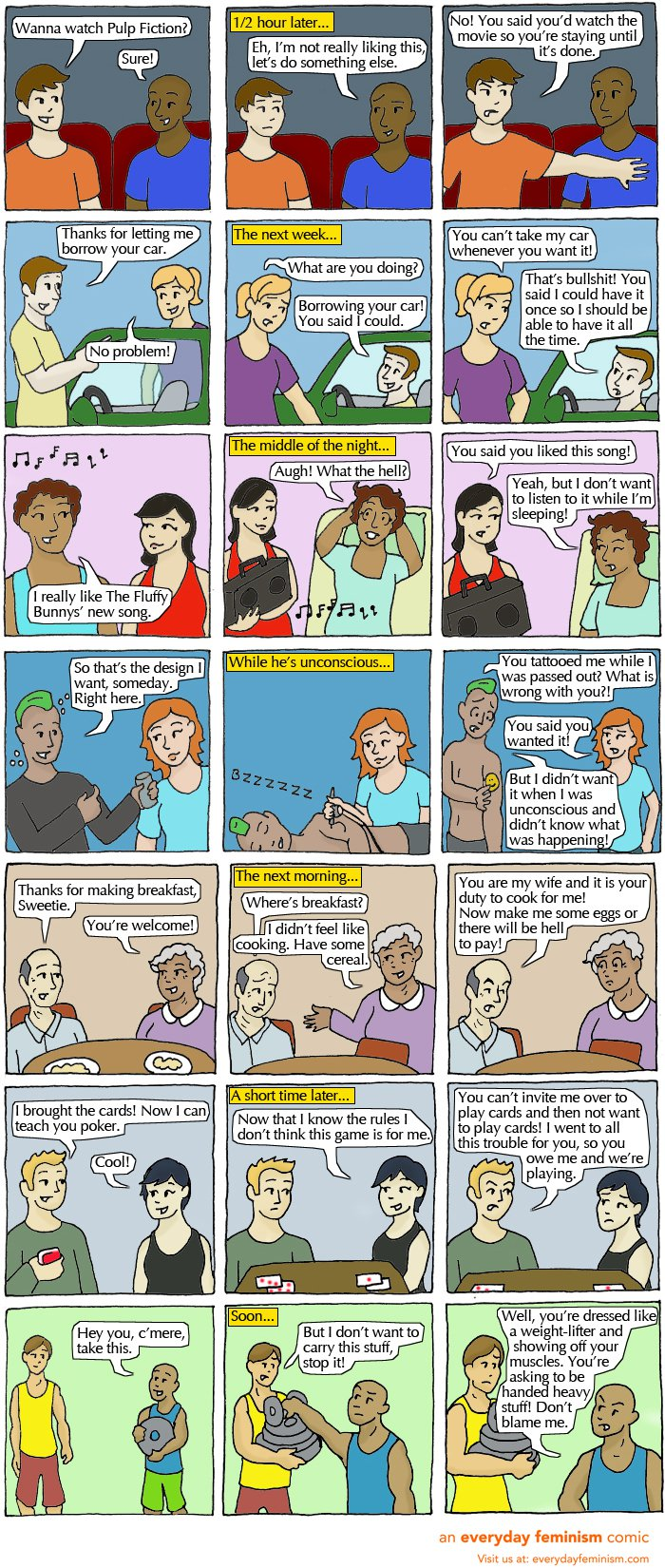Input + Discussion: Privacy, Consent and Safety [Deepening Activity]
This learning activity is about the trainer/facilitator giving input and facilitating a discussion on the issues relating to privacy, consent and safety.
About this learning activity
This learning activity is about the trainer/facilitator giving input and facilitating a discussion on the issues relating to privacy, consent and safety.
We suggest that you use this learning activity to cap the other learning activities such as: Unpacking "Safe" or The Bubble.
Learning objective this activity responds to
- Develop an understanding of privacy issues, and how privacy affects women and their lives.
Who is this activity for?
This activity can be used with participants with different levels of experience with both online space and creating safe spaces. Of course, if the participants have only a very basic understanding of feminist concepts such as agency and consent, then the trainer/facilitator will need to clarify those terms at the beginning of the input and discussion.
Time required
Minimum of 40 minutes.
Resources needed for this activity
- Flip chart paper or white board
- Markers
The trainer/facilitator can also opt to use a presentation for this activity.
Mechanics
If Unpacking "Safe" or The Bubble have already been done, use the insights from those activities to launch into defining privacy. Specifically:
- Draw from the the definitions of safety/safe that came from the activities that can be connected to privacy and consent issues.
- Key concepts raised during the prior learning activity that either need to be stressed/reiterated or further clarified (this is an opportunity to clarify notions/ideas that are against feminist values on privacy, consent and safety).
- Experiences shared in the prior activity that highlight the connections between privacy, consent and safety.
Unpacking consent and privacy
Key points to be raised in this input and discussion.
Unpacking "consent"
We tend to think of consent as a one-off thing. Like signing a piece of paper once and then it is set. However, from experience we know that consent is simple yet complex at the same time. Simple in its principle yet complex in its implications. Here are some things to discuss:
- Duration of consent.
- Ability to withdraw consent, what it means for a user to withdraw consent and their use of the platform or tool
- The data / information about the user that they cede when they consent to services
- How is that data used
- Conditions of consent – being able to consent only under certain circumstances and not others.
Watch the video Tea and Consent.
Show this graphic:
The facilitator can focus a few scenarios to highlight the points:
- Agreeing to the Terms of Service in proprietary, commercial platforms in order to be able to use that platform.
- Emergency scenarios where we consent to allow others to control our spaces / devices in order to safeguard it. How to we ensure that this conditional consent is temporary? Perhaps use the example of Facebook Trusted Friends as a way to highlight this point.
- Events that ask participants to sign-in at the door – what does that mean as far as consent goes?
- Sharing a password to a loved one as an act of intimacy and trust. What are the implications of this?
- Ask the participants for examples of situations where they had given their consent to different platforms or services.
Unpacking "privacy"
Key points for this input can include:
The different dimensions of privacy:
Territorial/spatial
- Why do we lock our doors? Which doors do we lock?
- How do we protect our spaces and why?
- Why do we close the door when we pee? When everyone does it?
Relational
- Do we protect the privacy of the people that we know? Who of them?
- Do we violate the privacy of our relatives, friends, colleagues when we talk about them?
Embodied
- Which parts of your body do you choose to disclose? When you pick what clothes to wear, and depending on who will see you (gaze as violation of privacy)?
- Embodiment online. Self-representation online. From simple things like user pics, to carefully crafted identities, to other kinds of information that reveals things about our bodies (health/medical/sexuality/gender). And how this also translates body as data.
Data privacy
- What data do we willingly cede about ourselves and others?
- Are we able to give consent to the collection, storage and aggregation of our data?
- How about the data about us that is collected, stored and aggregated without our consent?
Defining privacy
- Defining privacy as a fundamental human right, and why it is important for women.
- How privacy has been defined in policy (could be national, regional and international policy), and what that means for individuals, WHRDs and women.
- How privacy plays out on the internet: how social media has seemed to redefine privacy both in individual practice and the platform's use of users' data.
- How the internet – and how its being used and developed now – is challenging how we practise privacy.
- The relationship between privacy and consent.
Discussion questions
- When do we "forfeit" our right to privacy? For example: Does anonymity facilitate online harassment and GBV?
- How critical is the relationship between anonymity and privacy and safety?
- In the age of selfies and when people willingly cede information about themselves and others, is privacy dead?
- Technically, how would privacy-by-default work on the internet? What kind of changes would platforms like Facebook need to make to have privacy-by-default? (We could develop an activity around this in the future.)
Facilitator preparation notes
While this learning activity has the trainer/facilitator doing most of the speaking, it is also important to reiterate the safe, open and interactive space that all FTX workshops try to create. This can be done by framing this activity with guidelines that allow participants to raise their hands to ask questions or to argue or to stress or clarify a point being made in the presentation. The other way to encourage interactivity during presentation-style learning activities is to "popcorn" topics – ask a question to the group to start a topic, and then use their answers to launch a presentation/input.
In order to prepare for this learning activity, the trainer/facilitator will need to brush up on the following:
- The state of play on privacy issues – policies, trends, recent cases.
- Context-based understanding of privacy: current laws in the location of the workshop or the participants, recent cases relevant to the participants.
- Feminist Principles of the Internet
Additional resources
- Feminist Principles of the Internet
- "Neutral" definition of Consent (Merriam-Webster)
- "Neutral" definition of Consent (Wikipedia)
- "Neutral" definition of privacy (Merriam-Webster)
- "Neutral" definition of privacy (Wikipedia)
- Privacy and EDRI
- Three key issues for a feminist internet: Access, agency and movements
- A feminist internet and its reflection on privacy, security, policy and violence against Women
- GISWatch 2015: Sexual rights and the internet & Full report
- GISWatch 2013: Women’s rights, gender and ICTs & Report
- How much control do we have over our data?
- Establishing a baseline of privacy and security knowledge
- What privacy & anonymity have to do with tech-related VAW
- Invasion of Privacy & The Murder of Qandeel Baloch - By Digital Rights Foundation
- Peeping Tom Porn and Privacy - By Rohini Lakshané
- Mapping and privacy: Interview with Privacy International's Gus Hosein
- The ability to say NO on the Internet




